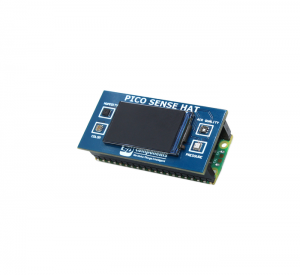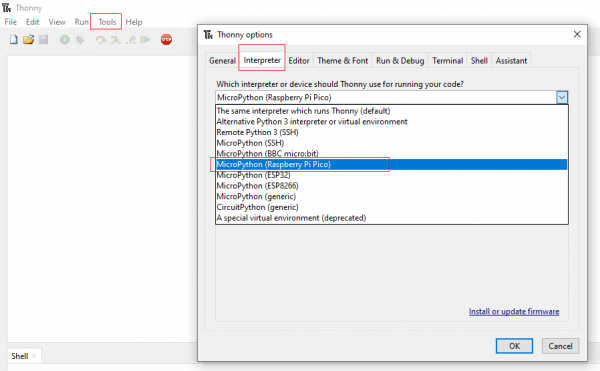Difference between revisions of "Pico-Sense-HAT"
From SB-Components Wiki
(Created page with "<div class="row"> <div class="large-8 column"> == Pico Cube == Pico Cube is a 4x4x4 LED cube HAT for Raspberry Pi Pico with 5V DC operating voltage. Pico cube, a monochroma...") |
|||
| (10 intermediate revisions by the same user not shown) | |||
| Line 1: | Line 1: | ||
<div class="row"> | <div class="row"> | ||
<div class="large-8 column"> | <div class="large-8 column"> | ||
| − | == Pico | + | == Pico Sense Hat == |
| − | + | Sense HAT for Raspberry Pi Pico is a four-sensor environment monitoring device that measures temperature, air quality, humidity, and colour. The Sense HAT board is perfect for the environment monitoring project since it has multi-sensors with the ability to measure temperature, humidity, air quality and colours. A stylish 1.14" LCD screen is also installed on the board, allowing the user to quickly see the data from the sensors on the screen. It will assist you in keeping track of the environment of your arenas, such as the office, home, or anywhere else. | |
=== Features === | === Features === | ||
| − | * Standard 40 Pins | + | * Multi Sensor HAT |
| − | * | + | * 1.14” LCD |
| − | * | + | * Standard 40 Pins Header |
| − | + | * Easy Interfacing | |
| − | + | * Compact Monitoring device | |
| + | |||
=== Specifications === | === Specifications === | ||
| − | * Operating Voltage - | + | * Operating Voltage - 3.3 V |
| − | * | + | * Humidity Sensor - BME280 |
| − | * | + | * Air Quality Sensor - SGP40 |
| − | * | + | * Temperature Sensor - SHT31 |
| + | * Colour Sensor - TCS34725 | ||
| + | * Communication - I2C/SPI | ||
| + | |||
</div> | </div> | ||
<div class="large-4 column"> | <div class="large-4 column"> | ||
| − | [[File: | + | [[File:Pico_sense_hat.png|thumb|left|alt=Pico Cube| Buy it From : ''[https://shop.sb-components.co.uk/products/pico-sense-hat Click Here]'']] |
</div> | </div> | ||
</div> | </div> | ||
| − | |||
| − | |||
== Installation == | == Installation == | ||
==== MicroPython ==== | ==== MicroPython ==== | ||
| − | * Stack Raspberry Pi Pico on the female header of Pico | + | * Stack Raspberry Pi Pico on the female header of Pico Sense HAT. |
* Connect USB cable on Raspberry Pi Pico USB port. | * Connect USB cable on Raspberry Pi Pico USB port. | ||
* Choose interpreter as MicroPython (Raspberry Pi Pico). | * Choose interpreter as MicroPython (Raspberry Pi Pico). | ||
[[File:Thonny-interpreter.PNG|600px]] | [[File:Thonny-interpreter.PNG|600px]] | ||
| − | * Download Pico | + | |
| − | Source code: https://github.com/sbcshop/ | + | * Save all the libraries inside the raspberry pi pico. |
| − | + | * Rename the pico_sense_hat.py to main.py and save it also inside pico (main.py code automatically run when pico power on). | |
| − | + | ||
| + | '''Files in the folder''' | ||
| + | |||
| + | In the folder, you will see 6 python files | ||
| + | * There are 5 libraries in this folder you need to save these libraries in the raspberry pi pico, 4 libraries of sensors, and 1 library of LCD display | ||
| + | * sgp40.py | ||
| + | * sht31.py | ||
| + | * bme280.py | ||
| + | * tcs34725.py | ||
| + | * Lcd1_14driver.py | ||
| + | |||
| + | * One file is there in the folder which runs the main code (this code display the sensor reading), this code import all the libraries of sensors and LCD display, | ||
| + | * pico_sense_hat.py | ||
| + | |||
| + | * Download Pico sense hat repository from the below link: | ||
| + | Source code: https://github.com/sbcshop/Pico-Sense-HAT | ||
== Resources == | == Resources == | ||
| + | <b> Github </b> | ||
| + | * [https://github.com/sbcshop/Pico-Sense-HAT.git Source Code] | ||
Latest revision as of 09:25, 8 January 2022
Pico Sense Hat
Sense HAT for Raspberry Pi Pico is a four-sensor environment monitoring device that measures temperature, air quality, humidity, and colour. The Sense HAT board is perfect for the environment monitoring project since it has multi-sensors with the ability to measure temperature, humidity, air quality and colours. A stylish 1.14" LCD screen is also installed on the board, allowing the user to quickly see the data from the sensors on the screen. It will assist you in keeping track of the environment of your arenas, such as the office, home, or anywhere else.
Features
- Multi Sensor HAT
- 1.14” LCD
- Standard 40 Pins Header
- Easy Interfacing
- Compact Monitoring device
Specifications
- Operating Voltage - 3.3 V
- Humidity Sensor - BME280
- Air Quality Sensor - SGP40
- Temperature Sensor - SHT31
- Colour Sensor - TCS34725
- Communication - I2C/SPI

Buy it From : Click Here
Installation
MicroPython
- Stack Raspberry Pi Pico on the female header of Pico Sense HAT.
- Connect USB cable on Raspberry Pi Pico USB port.
- Choose interpreter as MicroPython (Raspberry Pi Pico).
- Save all the libraries inside the raspberry pi pico.
- Rename the pico_sense_hat.py to main.py and save it also inside pico (main.py code automatically run when pico power on).
Files in the folder
In the folder, you will see 6 python files
- There are 5 libraries in this folder you need to save these libraries in the raspberry pi pico, 4 libraries of sensors, and 1 library of LCD display
* sgp40.py * sht31.py * bme280.py * tcs34725.py * Lcd1_14driver.py
- One file is there in the folder which runs the main code (this code display the sensor reading), this code import all the libraries of sensors and LCD display,
* pico_sense_hat.py
- Download Pico sense hat repository from the below link:
Source code: https://github.com/sbcshop/Pico-Sense-HAT
Resources
Github

